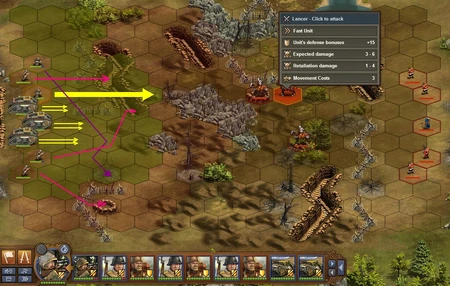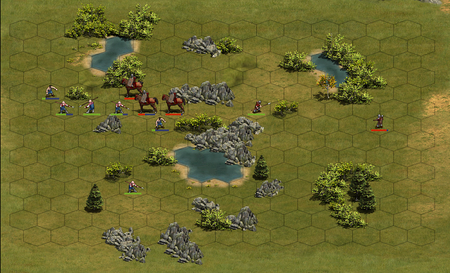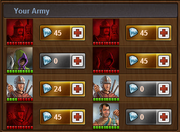Whoever wants to forge an empire must fight. In Forge of Empires, the military plays an important role. You can use your units to attack other players or conquer provinces on the Continent map. To go into battle, you first need units. You put these into slots in your military buildings. In your Army Management you can manage the units and add your attacking army or defending army.
Strategies in battle
Artillery units
Artillery units can be very useful when used in numbers. They should be used depending on the enemy troops. If the enemy has 1-3 heavy units, using 3-4 artillery units of the previous age (Or better the same age) is very helpful. The artillery units can take out all of the heavy units, making it extremely easy for all your other troops to win the battle. 2-3 Artillery units should also be used when there are 0-1 heavy units and 1-4 total artillery, ranged, or fast units. A good strategy is to target all of the attack from the artillery units on one other unit at a time, until they are all gone. If most of the units are light units, Artillery units should not be used.
Army Management
Here you can manage your units and assign them to both your attacking army and your defending army. In each of your armies, up to eight units can fight. You should always try to put as many troops as possible into an army. The units in your defending army defend your city. Fellow players have to defeat them when they attack you. But fear not: even if your opponent is victorious, all defenders will be healed and revived to full strength immediately after any battle. To assign units to defend your city, click the blue button on the left and then click on the units you want. You can select defending units from both the current attacking army and from the available units. If you have unbound units it is a good idea to use them for defense, as you risk losing them if you use them for attack. The assignment of a defending army is unlocked by completing the Military Tactics (tech) research in the Iron Age.
If you want to attack another player or an enemy on the Continent map, you use the units in your attacking army. They are not protected and therefore can be destroyed or damaged. So be careful!
Unit Types
In each age, there are five different military buildings that produce the different units of that time. The units differ in their type.: There are fast units, light and heavy units and units with ranged or artillery units attacks.
Fast units have a good range of movement, but they cannot take much damage. They are a great way to take out ranged classes.
The light units are genuine all-rounders: they are fast, inflict good damage and can withstand a lot. They are best at intercepting enemy fast units.
The heavy units are moderately slow and heavily armored. They are formidable opponents when they make it into close combat; there they outmatch any other unit.
Ranged units are fast and can attack from a distance, and their attack causes significant damage. However, they cannot defend themselves and are easy prey for all units which manage to attack them in close combat.
The artillery units are lost in close-range combat. They are very slow, very weak defense, and mediocre attack. Their big advantage is that they can cover almost the entire battle map with their attack and are able to selectively attack almost every unit. If used in numbers, it can take out enemy artillery units without getting damaged. It can also defeat most units from an age up and all the ages below.

_____________________________________________________________________________________
Movement and Attack
The battle is fought in rounds. Basically, each unit moves and attacks once per round. They move according to their movement points, but each type of terrain will cost a differing amount. Directly after movement, if there is an opponent within their reach, the units can attack. Melee classes and fast units have to attack into an adjacent field, while ranged classes can shoot at an enemy within their range.

There is no retaliation to fear from ranged attacks; however, in close-ranged battle, attacked fast and melee units can defend themselves. It works like this: First, the attacker does its damage, then the one being attacked hits back. However, there is only one counter-attack per round: even the strongest unit can be defeated by a swarm of enemies this way.
Damage
Each unit has a maximum of ten life points. The amount of damage points an attack deals is calculated using the current life points and the attack value of the attacker, the defense value of the attacked, modifiers for terrain, other bonuses (some units get bonuses if they fight against units of a particular type) and a random factor. Thus, a unit with a high attack rating deals more damage, and an uninjured unit inflicts more than a wounded one. On the other hand, high defense means good armor – the unit takes less damage. If a unit loses all its life points, it is destroyed.
Terrain
On the battle map, there are different types of terrain. Forests, bushes, rocks, hills, water bodies, plains and swamps are examples of them. The Terrain offers two different effects in the game: Firstly, it affects movement. Water areas are impassable, and other types of terrain costs extra movement points when they are crossed. On the other hand, terrain can give battle bonuses: light unit get defense bonuses in bushes and forests, heavy units are better protected in plains, artillery units receive an attack bonus when they shoot from hills, whereas those with ranged units attacks deal more damage standing on rocks. Only fast units do not receive benefits through the terrain. Rough terrain benefits ranged units that stand behind it as both melee classes have movement range that are significantly smaller, therefore allowing you to hit the enemy effectively without the enemy attacking your ranged units the following turn.
Buffs
The stats of units might get further influenced by a percentile boost. While on some provinces of the Continent map all enemy units in it gain a percentage bonus to their attack and defense stats (easily seen in the sector view as small shield icons on top of the unit images), there are two different buffs that can affect the armies of the players, both of which are accumulated from certain buildings such as the Watchfire and a small number of the Great Buildings:
Defense boost: All units in the defending army of this player get a bonus to their defense stat only, which means they take less damage when attacked.
Military boost: All units in the attacking army of this player get a bonus to both their attack and the defense stats, which means they take less damage and deal more.
Special Skills
There are some units in the game that add a further layer of tactical options to the players by featuring special skills. Right now the following skills are in the game:
- Blast: This skill is only found on 3 units with ranged attacks, i.e. Howitzer, Microwave Blaster and Exoskeleton Soldier. A unit with blast deals more damage for every field it is closer to its target and ignores stealth.
Stealth in (terrain): A unit with this skill can only be attacked from adjacent fields, as long as it stays in the specified terrain. For example, Jaeger Infantry, Ranger, Paratrooper, Commando, Strike Team, Stealth Tank, Hover Tank and Surrogate Soldier.
Secret Identity: A unit with this skill completely ignores the first attack it takes. Instead, it transforms into an undamaged copy of another unit of your army, that does not have secret identity. If no such unit is left, the attacked unit gets removed from battle instead. For example, Rogue
Chivalry: The skill is used by the High Middle Ages Knights and Late Middle Ages Heavy Knights (with Chivalry values of 3 and 5 respectively). The skill increases attack and defense when this is the only unit with chivalry in the army. Example: Champion (varies with values of respectively).
- Call of Duty: Grants attack and defense bonus to all friendly units when this unit is killed. (Can only be applied once.) Example: Champion.
- Dug in: Units with this skill gains defense bonus if the attacker is a certain amount of fields away. The distance varies upon the unit. Example: Cannon, Field Gun, Breech Loader, Rapid Fire Cannon, Sniper, Bazooka Team, MG Team, Anti-Materiel Sniper and Recon Raider.
- Rapid deployment: Units with this skill start the battle in a random location towards the center of the map and act before any other unit. Example: Paratrooper, Strike Team, Ultra AP and Drone Swarm.
- Close Quarters: Units with this skill gains attack bonus when attacking in adjacent field. Example: Conscript, Commando, Exoskeleton Soldier and Surrogate Soldier.
- Flying: Units with this skill cannot be attacked by artillery units and ignore terrain when moving. Example: Attack Helicopter, Combat Drone, Drone Swarm and Dragon Drone.
- Reactive Armor: Found on only 3 units, cannot take more than 4 damage per attack. Example: Assault Tank, Hover Tank and Battle Fortress.
- MIRV: A found only 1 unit in this skill, hits targeted units and between one and 3 additional units in range, able to target maximum 4 enemy units in one attack within range. Example: Missile Artillery.
- One-Shot: A found only 1 unit in this skill, unit is removed from battle after attacking and dies when battle is lost. Example: Missile Artillery.
- Contact!: Units with skill always retaliate against attacks within range, including enemy units are hidden. Example: MG Team, Anti-Aircraft Vehicle and Ultra AP.
- Heat: A found only 2 units in this skill, unit reduces enemy target's attack 20% and colors them red (does even stack). Example: Microwave Blaster and Satellite Spotter.
- Morale: A unit with this skill makes all friendly units start a battle with 1 point of armor, its will be extra 1 hp for all friendly units, for a total of 11 hit points. Does not stack. Example: Military Drummer.
- Recharge: A unit with this skill attacks every two turns. Example: Rail Gun.
- Power Shot: A unit with this skill ignores defensive skills and terrain, including ignoring Flying ability, Stealth, Dug-in, Chivalry, Call of Duty, Last Stand ignoring all enemy defense bonus from terrain, but does not ignore other skills, all enemy attack bonuses from terrain and enemy unit bonuses. Example: Rail Gun.
- Rally: A unit with this skill gives all friendly units with an attack and defense bonus at the beginning of a battle. Does not stack. Example: Color Guard and Military Drummer.
- Dragon Breath: A unit with this skill that attacks a row of enemies up to two tiles behind the target enemy without receiving retaliation. Example: Dragon Drone.
Healing
Is the battle over and your units have been damaged? No problem – they heal automatically over time, one life point at a time. Units that were destroyed in battle do not heal. Their corresponding slot in military building is freed again and you can recruit a new unit there.

You have a chance to resurrect a fallen unit right after a battle, using Diamonds – it could be worthwhile, especially if you've lost "unattached" units that are not from slots in military buildings but obtained through quests or events - a unit that you can't replace otherwise.
The shortest healing times are found on Bronze Age units, with the time to heal one hit point increasing in the Iron Age before reaching the maximum 24 minutes per hit point in the Early Middle Ages.
